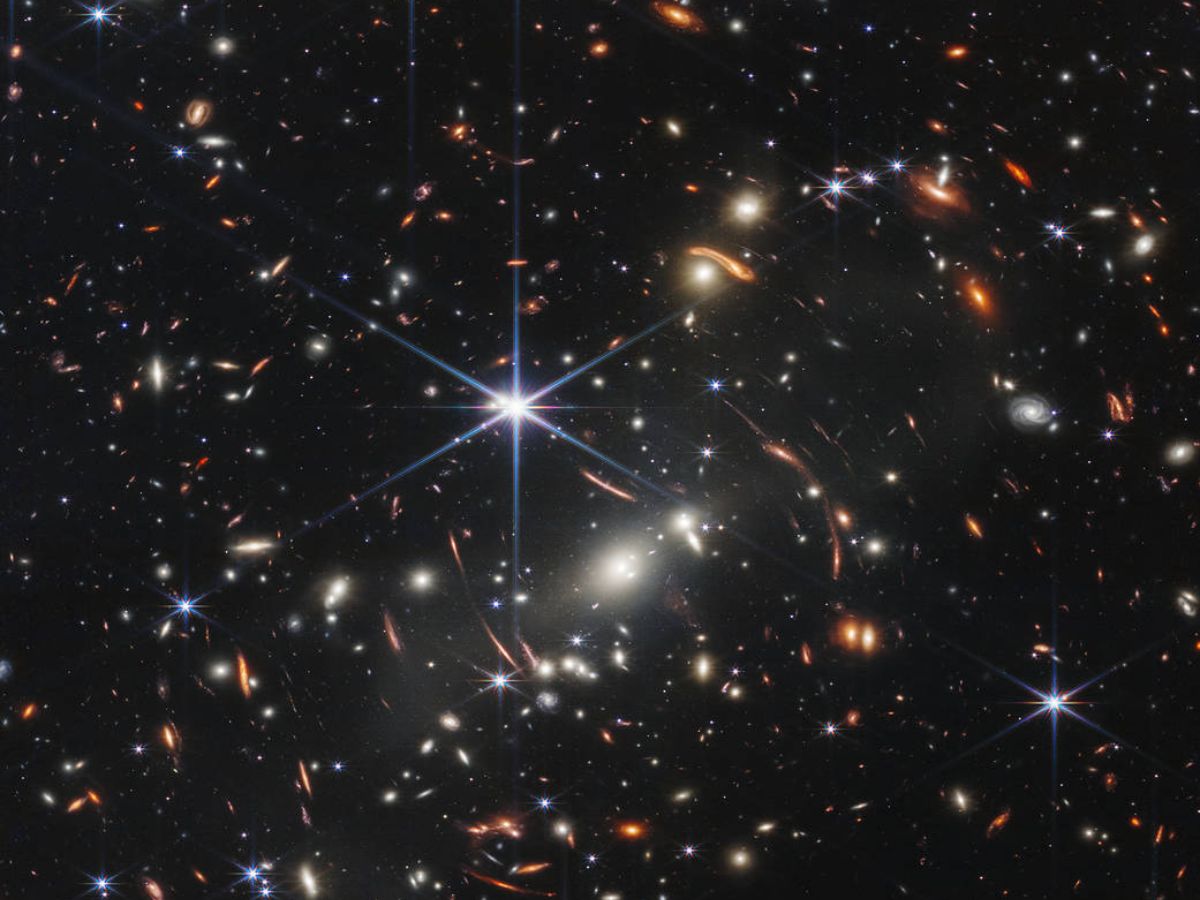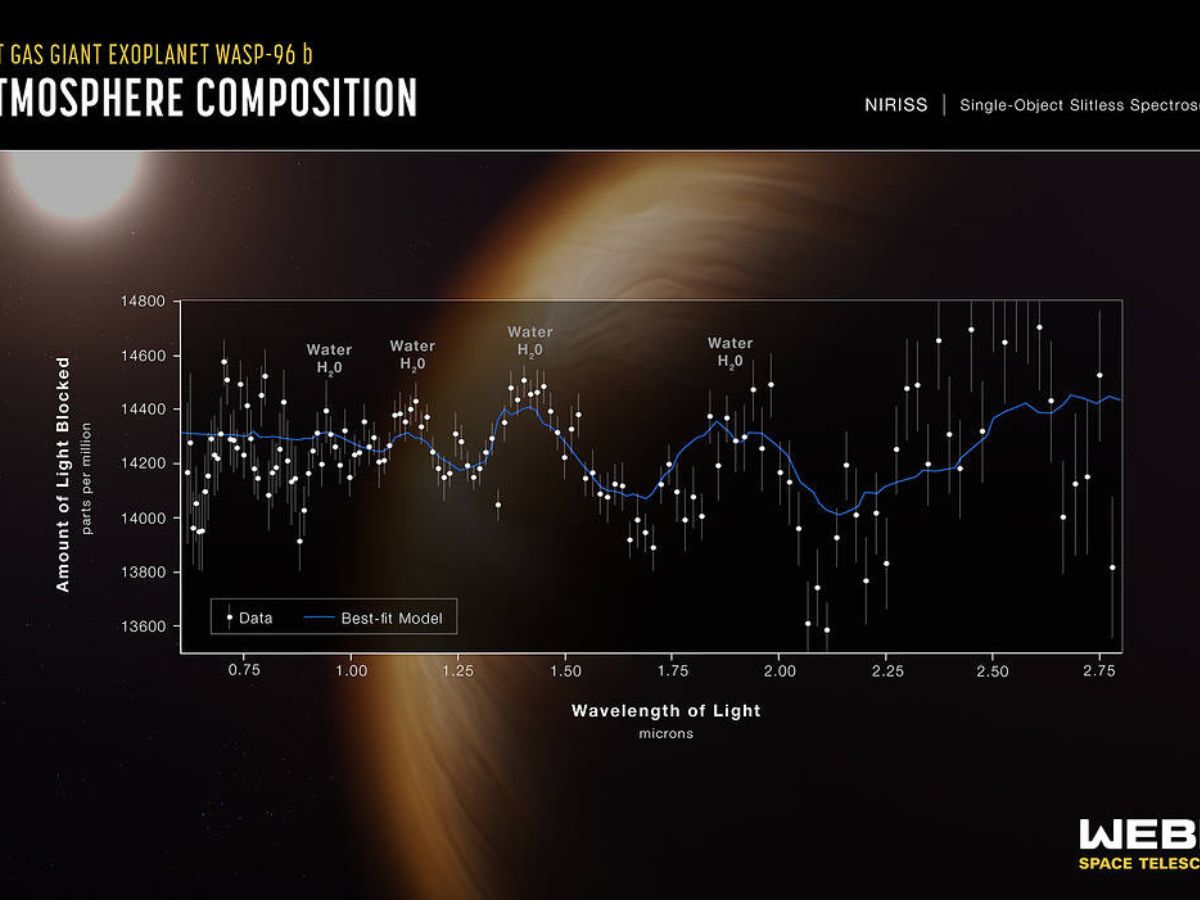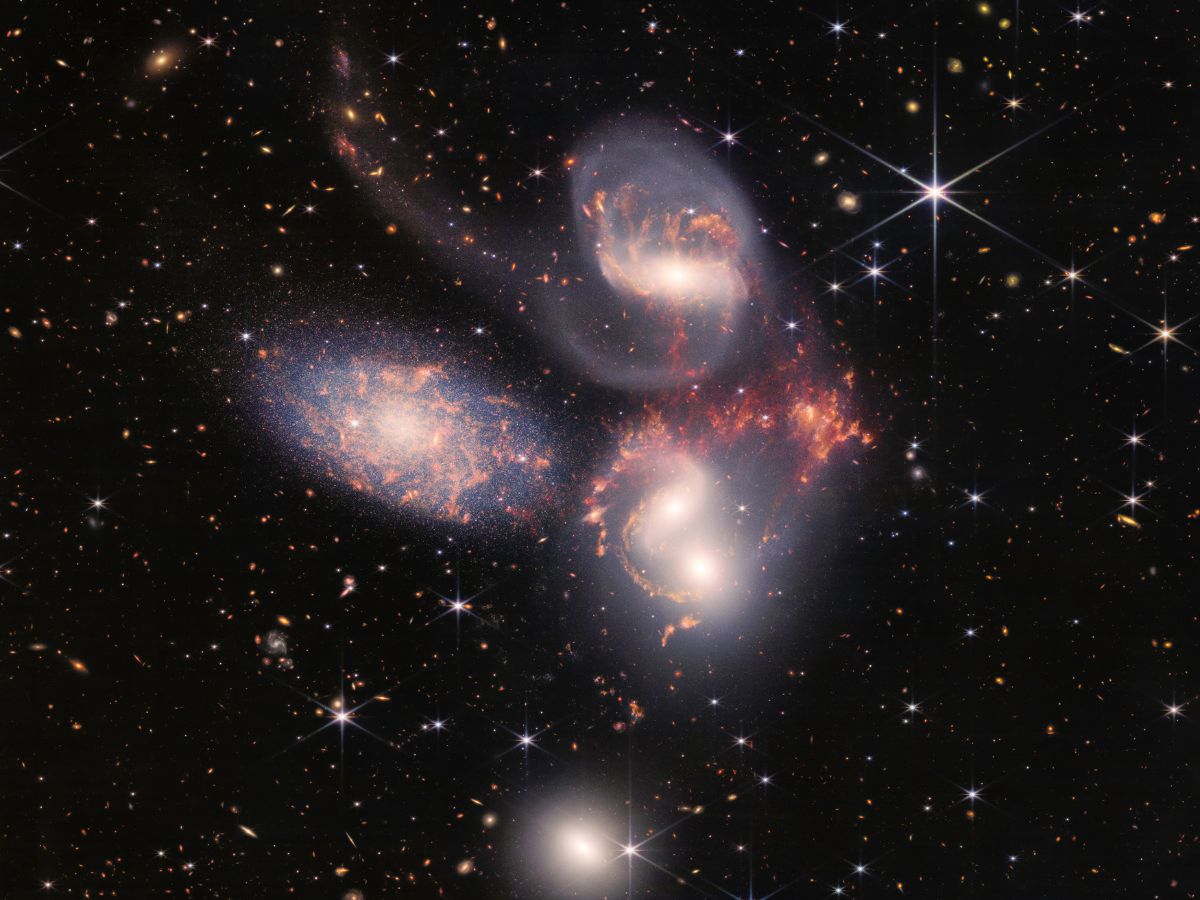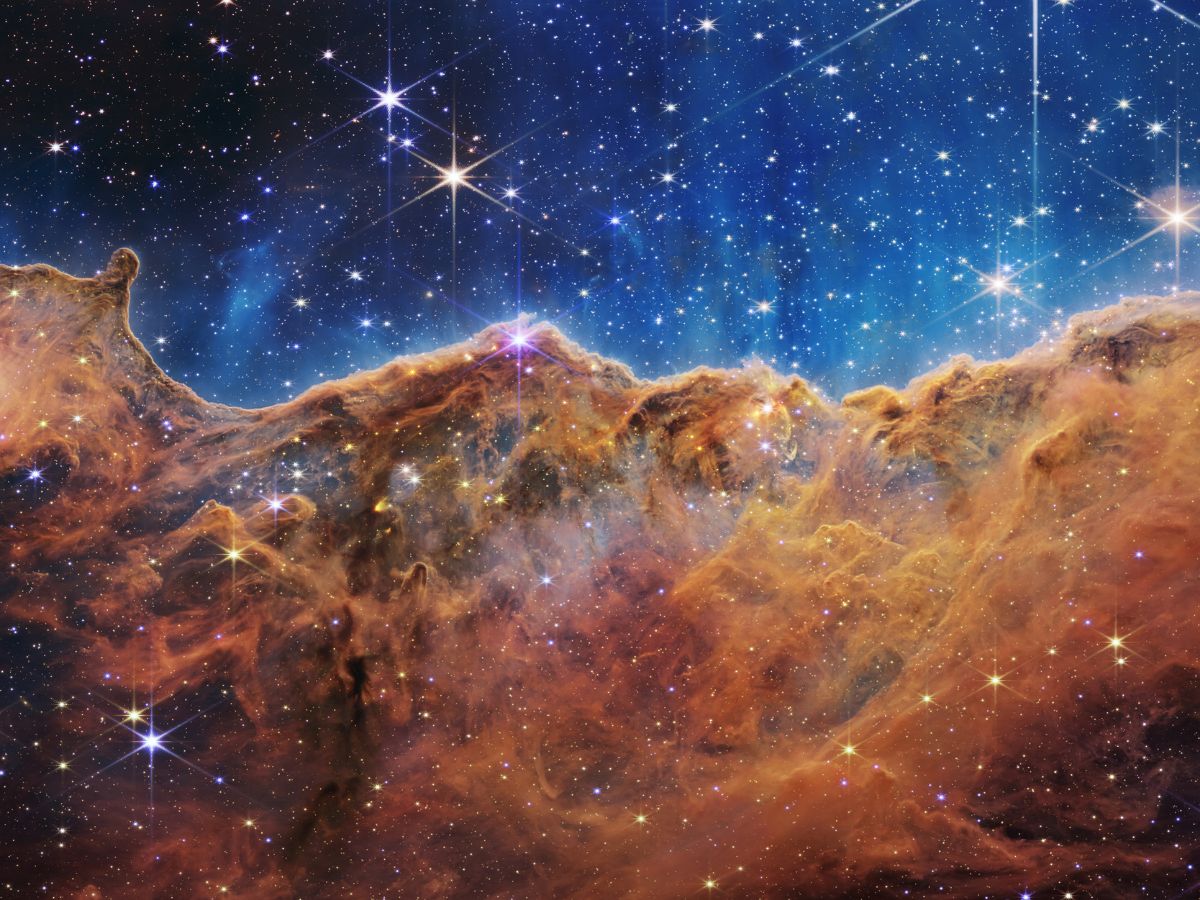Cosmic Cliffs, Dancing Galaxies – What NASA Webb's First Full-Colour Images Tell Us About The Cosmos | EXPLAINED
NASA released the first five full-colour images from the James Webb Space Telescope on Tuesday, July 12. The US space agency also quietly released two images of Jupiter captured by Webb.

NASA released the first five full-colour images from the James Webb Space Telescope on Tuesday, July 12. The world's most powerful space telescope has captured the image of a galaxy cluster as it appeared billions of years ago, detected the presence of water on an exoplanet, revealed exceptional details of the 'Eight-burst Nebula', shed light on galaxy evolution and black holes, and unveiled 'Cosmic Cliffs' in the Carina Nebula.
The President of the United States, Joe Biden, unveiled the deepest and the sharpest infrared image of the distant universe to date. This was the first full-colour image to be released from Webb.
NASA quietly released two more Webb images. These are the images of Jupiter, the Jovian moons Europa, Thebe and Metis, and the gas giant's ring. The pictures were captured while Webb was being tested, and have been provided in the JWST commissioning report.
Webb's full-colour images reveal several secrets about the cosmos.
Webb's First Deep Field: Deepest Image Of Early Universe

The deepest and sharpest infrared image of the distant universe so far is called Webb's First Deep Field. This is an image of the galaxy cluster SMACS 0723, and is "overflowing with detail", according to the European Space Agency. The galaxy cluster is present near the constellation Volans in the southern sky.
Thousands of galaxies and the faintest objects ever observed in infrared light have appeared in Webb's view.
The image has been captured by Webb's Near-Infrared Camera (NIRCam), and is a composite made from images at different wavelengths, totalling 12.5 hours. According to NASA, the combined mass of the galaxy cluster SMACS 0723 acts as a gravitational lens, magnifying more distant galaxies. The powerful gravitational field of the galaxy cluster bent the light rays from the distant galaxies behind it, similar to a magnifying glass.
Some of the galaxies are from the early universe, when the universe was less than a billion years old.
Webb's First Deep Field shows the galaxy cluster SMACS 0723 as it appeared 4.6 billion years ago. The NIRCam instrument has brought distant galaxies into sharp focus. These galaxies have tiny, faint structures that have never been seen before, including star clusters and diffuse features.
It took billions of years for the light from these galaxies to reach us. When viewing the youngest galaxies in Webb's First Deep Field, we are looking back in time to a few 100 million years after the Big Bang. Due to the expansion of the universe, the light was stretched to infrared wavelengths that Webb was designed to observe.
Webb has also captured stars, which appear brighter at shorter wavelengths.
The galaxy cluster has also been captured by Webb's Mid-Infrared Instrument (MIRI). The MIRI image offers a kaleidoscope of colours and highlights where the dust is present. Dust is a major ingredient for star formation, and ultimately for life.
Blue stars contain stars, but very little dust, while red objects are made up of thick layers of dust. Green galaxies contain hydrocarbons and other chemical compounds.
The data from Webb's Near Infrared Spectrograph (NIRSpec), which observed 48 individual galaxies at the same time, revealed light from one galaxy that travelled for 13.1 billion years before Webb's mirrors captured it.
WASP-96 b: Webb Detects Water In An Exoplanet’s Atmosphere

Webb has imaged the distinct signature of water, along with evidence for clouds and haze, in the atmosphere surrounding a hot, puffy, gas giant planet. The planet is orbiting a distant Sun-like star. Webb has revealed the steamy atmosphere of the distant planet in detail.
Webb's enormous mirror and precise instruments have captured the most detailed measurements of starlight filtering through the atmosphere of WASP-96 b, an exoplanet.
According to NASA, the spectrum of light, which contains information about the makeup of a planetary atmosphere 1,150 light-years away from Earth, reveals the distinct signature of water.
Webb's detailed observation of the atmosphere of an exoplanet marks a giant leap forward in the search for potentially habitable planets beyond Earth.
The image of the exoplanet was captured by the Near-infrared imager and slitless spectrograph (NIRISS), an instrument on Webb.
The JWST has detected the presence of specific gas molecules based on tiny decreases in the brightness of precise colours of light.
According to NASA, this observation is the "most detailed of its kind to date", and demonstrates Webb's ability to analyse atmospheres hundreds of light years away.
WASP-96 b, one of more than 5,000 confirmed exoplanets in the Milky Way, is located in the southern-sky constellation Phoenix. The exoplanet is a type of gas giant without any direct analogue in the solar system, and has a mass less than half that of Jupiter, and a diameter 1.2 times greater.
With a temperature greater than 1000 degrees Fahrenheit, WASP-96 b is significantly hotter, and orbits extremely close to its Sun-like star, at just one-ninth the distance between Mercury and the Sun.
The exoplanet is an ideal target for atmospheric observations because of the combination of large size, short orbital period, puffy atmosphere, and lack of contaminating light from objects nearby in the sky.
On June 21, Webb's NIRISS measured light from the WASP-96 b system for 6.4 hours as the planet moved across the star, and as a result, a light curve and a transmission spectrum were obtained. As the exoplanet transits the star's disc, its light dims.
The light curve confirms properties of the exoplanet that had previously been determined from other observations, and the transmission spectrum reveals previously hidden details of the atmosphere, including the unambiguous signature of water, indications of haze, and evidence of clouds that were not thought to exist.
By comparing the starlight filtered through a planet's atmosphere as it moves across the star to the unfiltered starlight detected when the planet is beside the star, researchers made a transmission spectrum. The NIRISS is the most detailed exoplanet spectrum to date.
According to NASA, the spectrum will help researchers measure the amount of water vapour in the atmosphere, determine the abundance of various elements like carbon and oxygen, and estimate the temperature of the atmosphere with depth. Using this information, researchers can determine the overall make-up of the planet, and know how, when, and where it formed.
Webb's 270-square-foot gold-coated mirror collects infrared light efficiently. The observation made by NIRISS demonstrates that Webb has the power to characterise the atmospheres of exoplanets, including those of potentially habitable planets, in exquisite detail.
Southern Ring Nebula: How A Dying Star Behaves

Webb's third image to be unveiled is that of the Southern Ring planetary nebula or the "Eight-burst Nebula". The nebula is approximately 2,500 light years away from Earth.
According to NASA, planetary nebulae are the shells of gas and dust ejected from dying stars.
Through its third full-colour image, Webb has revealed details of the Southern Ring planetary nebula that were previously hidden from astronomers. Shells of gas and dust ejected from dying stars constitute planetary nebulae.
The powerful infrared view of Webb has brought the nebula's second star into full view, along with exceptional structures created as the stars shape the gas and dust around them. The infrared view of the telescope also reveals details of the exceptional structures created as the stars shape the gas and dust around them.
According to NASA, new details from the late stages of a star's life will help the world better understand how stars evolve and transform their environments. The image has captured the "final performance" of a dying star in fine detail.
A cache of distant galaxies can also be seen in the background. Most of the multi-coloured points seen in the image are galaxies, not stars.
The Southern Ring planetary nebula has been imaged using the Near-Infrared Camera (NIRCam) and the Mid Infra-Red Instrument (MIRI).
Two stars, locked in a tight orbit, shape the local landscape of the cosmic entity. The image from Webb's NIRCam (left) shows the stars and their layers of light. Meanwhile, the image from Webb's MIRI (right) shows for the first time that the second star is surrounded by dust.
Hundreds of stars and background galaxies are seen in the near-infrared image, while dusty planet-forming disks around young stars are seen in the mid-infrared image.
According to NASA, the brighter star, which is in an earlier stage of its evolution, will probably eject its own planetary nebula in the future.
The brighter star influences the appearance of the nebula. As the two stars orbit one another, they "stir the pot" of gas and dust. This causes asymmetrical patterns.
The dimmer star seen at the centre of the nebula has been sending out rings of gas and dust for thousands of years in all directions, and Webb has revealed for the first time that the star is cloaked in dust.
According to NASA, each shell of gas represents an episode where the fainter star lost some of its mass. The widest shells of gas, seen toward the outer areas of the nebula, were ejected earlier. The shells of gas closest to the star and the most recent. By tracing these elections, researchers can look into the history of the system.
NIRCam has also made observations which reveal extremely fine rays of light around the planetary nebula. There are holes in the gas and dust from which starlight streams out.
According to NASA, observing a nebula is like watching a movie in exceptionally slow motion because planetary nebulae exist for tens of thousands of years. The shells of gas puffed by the star give researchers the ability to precisely measure the gas and dust present in the planetary nebula.
Dust and molecules form within the shells of material ejected by the star. This changes the landscape even as the star continues to expel material. The dust eventually enriches the areas around it, and expands into the Interstellar medium. The dust is very long-lived, because of which it may end up travelling through space for billions of years and become incorporated into a new star or planet.
The delicate layers of gas and dust seen in the Southern Planetary Nebula will dissipate into surrounding space in thousands of years.
Stephan's Quintet: Webb Captures Dancing Galaxies

The fourth full-colour image is that of a galaxy group called "Stephan's Quintet". Through its fourth full-colour image, Webb has revealed never-before-seen details of Stephan's Quintet. This visual grouping of five galaxies was prominently featured in the classic film, "It's a Wonderful Life".
Due to the close proximity of Stephen's Quintet, astronomers can see galactic mergers and interactions. The image shows in rare detail how interacting galaxies trigger star formation in each other and how gas in galaxies is being disturbed.
Webb has revealed never-before-seen details of a galaxy group called "Stephen's Quintet". Due to the close proximity of Stephen's Quintet, astronomers can see galactic mergers and interactions.
Stephan's Quintet was discovered by the French astronomer Édouard Stephan in 1877. It is located in the constellation Pegasus.
Webb's fourth image shows in rare detail how interacting galaxies trigger star formation in each other.
According to NASA, Webb's image shows outflows driven by a black hole in Stephan's Quintet in a level of detail never seen before.
The early universe was superheated, as a result of which infalling material may have fuelled very energetic black holes called quasars. Also, tight galaxy groups like Stephan's Quintet are likely to have been more common in the early universe.
The enormous mosaic of Stephan's Quintet is the largest image to date from the Webb Space Telescope. It contains over 150 million pixels and is constructed from almost 1,000 separate image files, and provides new insights into how galactic interactions may have driven galactic evolution in the early universe.
The MIRI and NIRCam instruments captured the visual grouping of the five galaxies of Stephan's Quintet. Together, the galaxies are also known as the Hickson Compact Group 92.
The galaxies in Stephan's Quintet are in a galactic dance with each other. The image sheds light into galaxy evolutions and black holes.
Webb's picture shows sparkling clusters of millions of young stars and starburst regions of fresh star birth.
Due to gravitational interventions, sweeping tails of gas, dust and stars are being pulled from several of the galaxies. Webb has captured huge shock waves as one of the galaxies, NGC 7318B, smashed through the cluster.
Only four of the galaxies in Stephan's Quintet are truly close together and caught in a cosmic dance. NGC 7320, the fifth and leftmost galaxy, is in the foreground, compared with the other four. The galaxy is present 40 million light-years away from Earth. Meanwhile, the other four galaxies — NGC 7317, NGC 7318A, NGC 7318B, and NGC 7319 — are about 290 million light-years away from Earth.
According to NASA, this distance is fairly close in cosmic terms, compared with more distant galaxies billions of light-years away. Scientists can better understand structures seen in a much more distant universe by studying such relatively nearby galaxies.
Scientists rarely get the opportunity to see in detail how interacting galaxies trigger star formation in each other, and how the gas in these galaxies is being disturbed. According to NASA, Stephan's Quintet is a fantastic "laboratory" for studying these processes fundamental to all galaxies.
NGC 7319, the topmost galaxy in the group, harbours an active galactic nucleus, which is a supermassive black hole 24 million times the mass of the Sun. The active galactic nucleus is actively pulling in material and puts out light energy equivalent to 40 billion Suns.
Using the Near-Infrared Spectrograph (NIRSpec) and MIRI, Webb has studied the active galactic nucleus in great detail. The instruments helped the Webb team obtain a collection of images of the galactic core's spectral features.
The telescope pierced through the shroud of dust surrounding the nucleus to reveal hot gas near the active black hole and measure the velocity of bright outflows, and saw the outflows driven by the black hole in unprecedented detail.
Webb was able to resolve individual stars in NGC 7320 and also the galaxy's bright core.
The JWST revealed a vast sea of thousands of distant background galaxies as a bonus.
The most detailed image of the Stephan's Quintet, along with Webb data, will help scientists understand the rate at which supermassive black holes feed and grow, and to see star-forming regions more directly.
Cosmic Cliffs: Glittering Landscape Of Starbirth

The fifth and final full-colour image captured by the James Webb Space Telescope is that of the Carina Nebula. The image reveals baby stars in the Carina Nebula, where ultraviolet radiation and stellar winds shape colossal walls of dust and gas.
Webb's fifth and final full-colour image reveals emerging stellar nurseries and individual stars in the Carina Nebula.
The image is called "Cosmic Cliffs", and is a seemingly three-dimensional picture. A landscape of "mountains" and "valleys" speckled with glittering stars can be seen in the image.
The landscape is the edge of a nearby, young star-forming region called NGC 3324 in the Carina Nebula. Webb has captured the image in infrared light.
“Cosmic Cliffs” reveals for the first time previously invisible areas of star birth. The image reveals the "glittering landscape" of star birth.
Webb's extreme sensitivity, spatial resolution, and imaging capability helped capture the cosmic objects in the earliest, rapid phases of star formation.
NGC 3324 is located roughly 7,600 light-years away from Earth. Webb's NIRCam and MIRI captured the star-forming region. The tallest peaks seen in the image are about seven light-years high.
Due to intense ultraviolet radiation and stellar winds from extremely massive, hot, young stars, a cavernous area has been carved from the nebula. The young stars are located in the centre of the bubble. The stars can be seen in the top of the image.
Webb's NIRCam instrument has unveiled hundreds of previously hidden stars, and even numerous background galaxies.
MIRI has revealed the structures that are embedded in the dust and uncovered the stellar sources of massive outflows.
According to NASA, the blistering, ultraviolet radiation from the young stars is sculpting the Carina nebula's wall by slowly eroding it away. Pillars resisting this radiation tower above the glowing wall of gas.
A "steam" appears to rise from the celestial "mountains". The steam is actually hot, ionised gas and hot dust streaming away from the nebula due to the blistering ultraviolet radiation.
Through its infrared vision, Webb reveals emerging stellar nurseries and individual stars that are completely hidden in visible-light pictures. Webb can peer through cosmic dust to see objects because of its sensitivity to infrared light.
Protostellar jets, which are intriguing signspots of star formation, can be seen in the image. These jets shoot out from some of the young stars.
The youngest stars appear as red spots in the dark, dusty region of the cloud, according to NASA.
Webb's observations of NGC 3324 will shed light on the process of star formation. The birth of a star propagates over time, and is triggered by the expansion of the eroding cavity.
The bright, ionised rim moves into the nebula, and slowly pushes into the gas and dust.
The pressure in the rim may increase if it encounters any unstable material. This will trigger the material to collapse and form new stars.
However, the same disturbance may prevent star formation. This is because the star-forming material is eroding away. According to NASA, this is a very delicate balance between sparking star formation and stopping it. Some of the questions of modern astrophysics which Webb will answer include what determines the number of stars forming in a certain region and why stars form with a certain mass.
Other information which Webb will unveil include the impact of star formation on the evolution of gigantic clouds of gas and dust. Low-mass stars create narrow, opposing jets as they form. This injects a lot of momentum and energy into the clouds of gas and dust, reducing the fraction of nebular material that seeds new stars.
Webb's NIRCam, which has crisp resolution and unparalleled sensitivity, has unveiled hundreds of previously hidden stars, and numerous background galaxies.
Young stars and their dusty planet-forming disks have appeared in MIRI's view. These discs shine brightly in the mid-infrared, and appear pink and red. MIRI has revealed structures embedded in the dust, and has uncovered the stellar sources of massive jets and outflows.
Scottish astronomer James Dunlop was the first to catalogue NGC 3324. The star-forming region is located at the northwest corner of the Carina Nebula, which resides in the constellation Carina.
The Keyhole Nebula, and the active, unstable supergiant star called Eta Carinae are also present in the Carina Nebula.
Jupiter, Its Moons, And Ring

Webb has tracked solar system objects at speeds more than twice the requirement. The telescope has detected faint galaxies and observed targets as bright as Jupiter.
The telescope tracked Jupiter using instruments such as NIRCam, NIRISS (Near-Infrared Imager and Slitless Spectrograph), and the MIRI MRS (medium-resolution spectrometer).
One of Webb's programmes demonstrated that the telescope can track moving targets even when there is scattered light from a bright Jovian planet.
The NIRCam instrument captured two images of Jupiter. One of the pictures is a short-wavelength image while the other is a long-wavelength image.
In both the images, the Jovian moons Europa, Thebe and Metis can be seen. The shadow of Europa is also visible, just to the left of the Great Red Spot on Jupiter. The gas giant's ring is faintly visible in the Webb images.
The JWST is an international collaboration between NASA, European Space Agency (ESA) and the Canadian Space Agency (CSA). After decades of wait, Webb was launched into space on December 25, 2021, atop an Ariane 5 rocket from the Guiana Space Centre located near Kourou, French Guiana.
Webb will examine every phase of cosmic history, from the first luminous glows after the Big Bang to the formation of galaxies, stars, and planets, and the evolution of our own solar system.





































